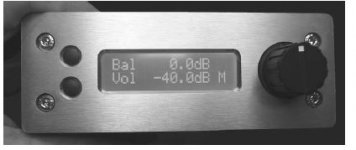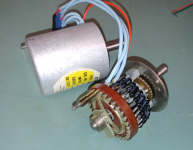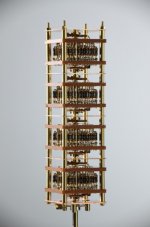Yes my miniDSP has digital volume control, but this has some problems not least no way of telling what the setting is!!!
you could add a display... or... use your ears!! 😀
I hate to burst the bubble about the Alps Black Beauty "pots". They are stepped attenuators inside on a ceramic substrate. Very nicely made, but they can and do wear out, I've had to replace a couple of them as control room consoles monitor volume controls.
I replaced them with Goldpoint attenuators. I like ELMA switches, I've rarely had a problem even in 50 year old Neve channel strips.
TKD makes very usable pots, but their construction is not as good as the P&G's. With a P&G I can replace every component if it has a problem or wears. The TKD I have to throw away with its stamped metal parts and marginal crimp connections. In theory I could re-trim a P&G fader as they are custom factory trimmed for channel match when made, but of course any mechanical change (sliding the element relative to the other say) is going to change the balance.
The rotary P&G's I was never as impressed with because they wore out and had to be replaced, they are not field serviceable. And quite expensive.
But by far the best for tracking and repeatability are the relay driven attenuators. I have been using a Crane Song Avocet for years as my monitor controller, its based on relay attenuators, as well as other switching for production work (polarity, mono, level offsets, etc). I used to never quite believe balance and level before I got that, now, it just is correct.
Scott, those little Teledyne relays are generally quite excellent, have a few in things I've built over the years. Very long useful life.
Cheers
Alan
I replaced them with Goldpoint attenuators. I like ELMA switches, I've rarely had a problem even in 50 year old Neve channel strips.
TKD makes very usable pots, but their construction is not as good as the P&G's. With a P&G I can replace every component if it has a problem or wears. The TKD I have to throw away with its stamped metal parts and marginal crimp connections. In theory I could re-trim a P&G fader as they are custom factory trimmed for channel match when made, but of course any mechanical change (sliding the element relative to the other say) is going to change the balance.
The rotary P&G's I was never as impressed with because they wore out and had to be replaced, they are not field serviceable. And quite expensive.
But by far the best for tracking and repeatability are the relay driven attenuators. I have been using a Crane Song Avocet for years as my monitor controller, its based on relay attenuators, as well as other switching for production work (polarity, mono, level offsets, etc). I used to never quite believe balance and level before I got that, now, it just is correct.
Scott, those little Teledyne relays are generally quite excellent, have a few in things I've built over the years. Very long useful life.
Cheers
Alan
How about plugging in separate little resistor dividers everytime you want to change the volume, they could be numbered so Bill could tell how loud it was.
...With a P&G I can replace every component if it has a problem or wears...In theory I could re-trim a P&G fader as they are custom factory trimmed for channel match when made, but of course any mechanical change (sliding the element relative to the other say) is going to change the balance.
I second that, I maintain consoles with a total of a hundred P&G 2100 series linears, and I think maybe three or four have worn out in 30+ years of 24/7 use although I have rebuilt a few, as Alan said parts are available. And when DJs violate the "No Drinks In The Control Room!" signs and drop cola or worse into them like this example, they disassemble, wash out with plain water and are back in service for years. Fantastic!
...The rotary P&G's I was never as impressed with because they wore out and had to be replaced, they are not field serviceable. And quite expensive.
Cheers
Alan
I have had very few issues with P&G rotaries, and the channel to channel tracking is excellent, easily +/-0.5 dB...I guess YMMV!
Cheers,
Howie
... about the Alps Black Beauty "pots". They are stepped attenuators inside on a ceramic substrate. Very nicely made, but they can and do wear out...
Nope, they are potentiometers with continuous rotation, not switches; the smaller RK27 (Blue Velvet) have mechanical indents to mimic the feel of switches, but they're also potentiometers. And yes, they're rated for 15K cycles, so replacements are to be expected for pro use.
Attachments
Will you include a Balance Control function in this collection of relays? Balance control external to the volume control relays? No Balance control at all?
Balance appears to introduce uncomfortable tradeoffs involving latching vs nonlatching relays, 2xSPDT versus 1xDPDT relays, and perhaps more.
Not planning to Mark - both channels are driven together in the current design, but you've got me thinking . . . since the control is by means of a rotary encoder (RE) feeding into a micro, I could quite easy separate them (plenty of uC I/O so that's not an issue). Straight volume control, then depress the RE P/B to implement the balance function. I think you only need 6~8 dB control range for balance - I've never used them to be honest and even on the Marantz amp it was always left centred.
Its also remote controllable BTW - no point in skipping this if there's a controller hanging about.
Last edited:
Nope, they are potentiometers with continuous rotation, not switches; the smaller RK27 (Blue Velvet) have mechanical indents to mimic the feel of switches, but they're also potentiometers. And yes, they're rated for 15K cycles, so replacements are to be expected for pro use.
The indents are an option - they are usually available without. I use the 10k log taper types. I have to say that supply has gotten a bit inconsistent over the last year or two - Familygate in Germany used to carry loads of stock but not so much anymore.
P & G is owned by Curtiss Wright. I used to work for a different CW division.
I kick myself for not buying a few pots, I could get them at cost.
I kick myself for not buying a few pots, I could get them at cost.
The indents are an option - they are usually available without. I use the 10k log taper types. I have to say that supply has gotten a bit inconsistent over the last year or two - Familygate in Germany used to carry loads of stock but not so much anymore.
I think they're replaced by the RK271; Mouser has plenty of them.
Problem with just using ears is that little darlings go 'ooh can I twiddle that'. The display is a good idea and luckily the fine Mr Didden has an answer for that. A remote display and volume control with proper knobs and such. I can run the miniDSP hot and adjust in the analog domain.you could add a display... or... use your ears!! 😀
In an active system? You're having a Giraffe!How about plugging in separate little resistor dividers everytime you want to change the volume, they could be numbered so Bill could tell how loud it was.
Attachments
Instead of a rotary encoder, you could always use a linear pot and convert the value with an MCU ADC so you can get the smooth feel and mechanical stop.
I could but then I would have to drill another hole in my miniDSP or build something vastly more complex. Trying to avoid new projects in 2019 until backlog is dealt with (and if you believe that....). 😀
This is what we built for the modified Spectral preamp- A tech Labs 24 position switch (silver contacts and silver wipers) with either Holco (shown) or Vishay S102 resistors. The Vishay version was a $1000 upgrade in the early '90's but was most of what we built. They don't wear out. However Techlabs has vanished and Daven got swallowed up by Shallco and doesn't show on their site any more. TKD made this type of switch as a pot but may not any more. IET may still make that type of switch for the precision resistor boxes but its not a common part any more. If someone wanted to make them they are not complex with difficult to make parts or special tooling.
Tech labs was specific about not using PCB's as a substrate. They said that the connections to the contacts fail over time. Use wires. . .
I managed to get two Radiometer CLT-1's to evaluate pots. One for the source and a second to measure at the output terminals. Alps pretty good Alpha 40 dB worse distortion.
This Bourns pot https://www.bourns.com/docs/product-datasheets/slimline.pdf?sfvrsn=ba6b28e_1 was the only pot that seems to have the same audio performance as the Vishay switch. Only available as a single gang. Detents are available.
Tech labs was specific about not using PCB's as a substrate. They said that the connections to the contacts fail over time. Use wires. . .
I managed to get two Radiometer CLT-1's to evaluate pots. One for the source and a second to measure at the output terminals. Alps pretty good Alpha 40 dB worse distortion.
This Bourns pot https://www.bourns.com/docs/product-datasheets/slimline.pdf?sfvrsn=ba6b28e_1 was the only pot that seems to have the same audio performance as the Vishay switch. Only available as a single gang. Detents are available.
Attachments
Not likely to wear out in a normal human lifetime. The contact surfaces are at least .031 of silver and there are two wipers on any contact. No you may need to clean them if they aren't used. The bearings are pretty substantial. The detent is substantial as well.
While we are on this, I amused myself to recalculate a stepping volume with resistances.
Input impedance of ~20K.
Output impedance constant around 6.8K.
24 Steps with constant attenuation of 2.1dB at each step (logarithmic).
22 X 3.3K
20 X 56K
2 X 6.8K
1 X 10K
1 X 4 K
Any comment ? Do you think steps of 2dB ok for home use ?
Max attenuation of ~48dB large enough ?
Input impedance of ~20K.
Output impedance constant around 6.8K.
24 Steps with constant attenuation of 2.1dB at each step (logarithmic).
22 X 3.3K
20 X 56K
2 X 6.8K
1 X 10K
1 X 4 K
Any comment ? Do you think steps of 2dB ok for home use ?
Max attenuation of ~48dB large enough ?
- Status
- Not open for further replies.
- Home
- Member Areas
- The Lounge
- John Curl's Blowtorch preamplifier part III


